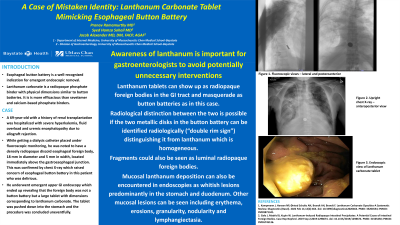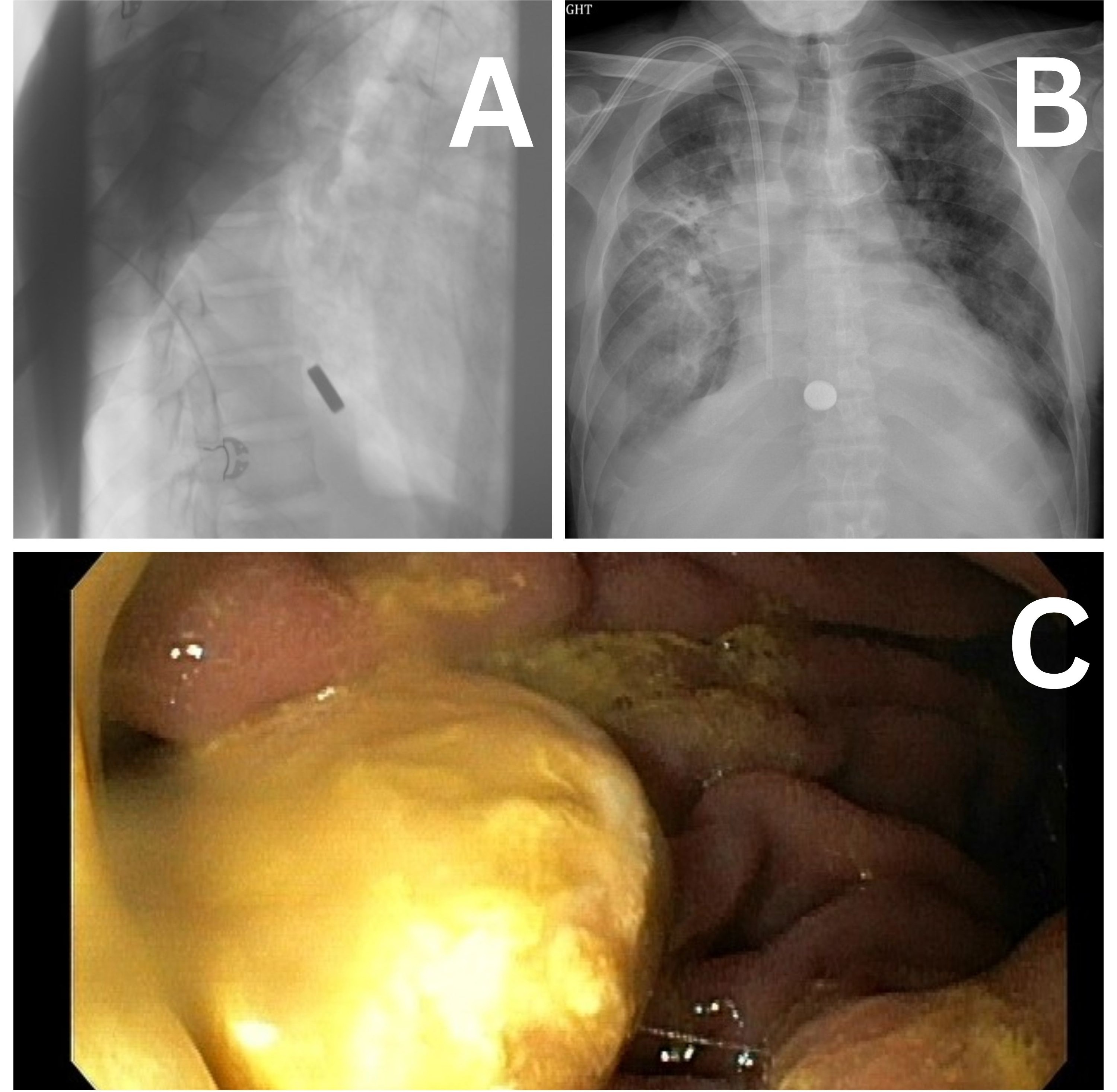Monday Poster Session
Category: General Endoscopy
P2428 - A Case of Mistaken Identity: Lanthanum Carbonate Tablet Mimicking Esophageal Button Battery
Monday, October 28, 2024
10:30 AM - 4:00 PM ET
Location: Exhibit Hall E

Has Audio
- PR
Pranav S. Ramamurthy, MD
University of Massachusetts Chan Medical School - Baystate Medical Center
Springfield, MA
Presenting Author(s)
Pranav S. Ramamurthy, MD1, Syed Hamza Sohail, MD2, Jacob Alexander, MD, DM3
1University of Massachusetts Chan Medical School - Baystate Medical Center, Springfield, MA; 2University of Massachusetts Chan Medical School - Baystate Health, Springfield, MA; 3Baystate Medical Center, Springfield, MA
Introduction: Esophageal button battery is a well-recognized indication for emergent endoscopic removal. Lanthanum carbonate is a radiopaque phosphate binder with physical dimensions similar to button batteries. We report a case of esophageal lanthanum tablet masquerading the appearance of a button battery leading to emergent endoscopic intervention.
Case Description/Methods: A 69-year-old man who had previously undergone renal transplantation was hospitalized with severe hyperkalemia, fluid overload and uremic encephalopathy due to allograft rejection. He was emergently started on hemodialysis, but as the renal failure persisted, decision was made to place a tunneled dialysis catheter. While getting the dialysis catheter placed under fluoroscopic monitoring, he was noted to have a densely radiopaque discoid esophageal foreign body, 18 mm in diameter and 5 mm in width, located immediately above the gastroesophageal junction. A chest X-ray was obtained which redemonstrated the same and raised concern of esophageal button battery in this patient who was delirious. He underwent emergent upper GI endoscopy which ended up revealing that the foreign body was not a button battery but a large tablet with dimensions corresponding to lanthanum carbonate that he was taking as a phosphate binder. The tablet was pushed down into the stomach and the procedure was concluded uneventfully.
Discussion: Lanthanum carbonate is a phosphate binder that is more efficacious than sevelamer and calcium-based phosphate binders. There are two clinical effects of lanthanum that gastroenterologists might incidentally encounter. Firstly, they can show up as radiopaque foreign bodies in the GI tract. When these tablets are inadvertently swallowed without chewing, they can masquerade as button batteries as in this case. Radiological distinction between the two is possible if the two metallic disks in the button battery can identified radiologically (“double rim sign”) distinguishing it from lanthanum which is homogeneous. Even when the tablets are swallowed after chewing, the fragments could be seen as luminal radiopaque foreign bodies. Secondly, mucosal lanthanum deposition can be encountered in endoscopies as whitish lesions predominantly in the stomach and duodenum. It has also been known to cause mucosal lesions including erythema, erosions, granularity, nodularity and lymphangiectasia. Being aware of these would help avoid unnecessary diagnostic testing in these patients.

Disclosures:
Pranav S. Ramamurthy, MD1, Syed Hamza Sohail, MD2, Jacob Alexander, MD, DM3. P2428 - A Case of Mistaken Identity: Lanthanum Carbonate Tablet Mimicking Esophageal Button Battery, ACG 2024 Annual Scientific Meeting Abstracts. Philadelphia, PA: American College of Gastroenterology.
1University of Massachusetts Chan Medical School - Baystate Medical Center, Springfield, MA; 2University of Massachusetts Chan Medical School - Baystate Health, Springfield, MA; 3Baystate Medical Center, Springfield, MA
Introduction: Esophageal button battery is a well-recognized indication for emergent endoscopic removal. Lanthanum carbonate is a radiopaque phosphate binder with physical dimensions similar to button batteries. We report a case of esophageal lanthanum tablet masquerading the appearance of a button battery leading to emergent endoscopic intervention.
Case Description/Methods: A 69-year-old man who had previously undergone renal transplantation was hospitalized with severe hyperkalemia, fluid overload and uremic encephalopathy due to allograft rejection. He was emergently started on hemodialysis, but as the renal failure persisted, decision was made to place a tunneled dialysis catheter. While getting the dialysis catheter placed under fluoroscopic monitoring, he was noted to have a densely radiopaque discoid esophageal foreign body, 18 mm in diameter and 5 mm in width, located immediately above the gastroesophageal junction. A chest X-ray was obtained which redemonstrated the same and raised concern of esophageal button battery in this patient who was delirious. He underwent emergent upper GI endoscopy which ended up revealing that the foreign body was not a button battery but a large tablet with dimensions corresponding to lanthanum carbonate that he was taking as a phosphate binder. The tablet was pushed down into the stomach and the procedure was concluded uneventfully.
Discussion: Lanthanum carbonate is a phosphate binder that is more efficacious than sevelamer and calcium-based phosphate binders. There are two clinical effects of lanthanum that gastroenterologists might incidentally encounter. Firstly, they can show up as radiopaque foreign bodies in the GI tract. When these tablets are inadvertently swallowed without chewing, they can masquerade as button batteries as in this case. Radiological distinction between the two is possible if the two metallic disks in the button battery can identified radiologically (“double rim sign”) distinguishing it from lanthanum which is homogeneous. Even when the tablets are swallowed after chewing, the fragments could be seen as luminal radiopaque foreign bodies. Secondly, mucosal lanthanum deposition can be encountered in endoscopies as whitish lesions predominantly in the stomach and duodenum. It has also been known to cause mucosal lesions including erythema, erosions, granularity, nodularity and lymphangiectasia. Being aware of these would help avoid unnecessary diagnostic testing in these patients.

Figure: A - Fluoroscopy demonstrating densely radiopaque discoid esophageal foreign body from lateral view
B - Chest X-ray redemonstrating densely radiopaque discoid esophageal foreign body
C - Large tablet resembling lanthanum carbonate as seen on endoscopy after being pushed down into the stomach
B - Chest X-ray redemonstrating densely radiopaque discoid esophageal foreign body
C - Large tablet resembling lanthanum carbonate as seen on endoscopy after being pushed down into the stomach
Disclosures:
Pranav Ramamurthy indicated no relevant financial relationships.
Syed Hamza Sohail indicated no relevant financial relationships.
Jacob Alexander indicated no relevant financial relationships.
Pranav S. Ramamurthy, MD1, Syed Hamza Sohail, MD2, Jacob Alexander, MD, DM3. P2428 - A Case of Mistaken Identity: Lanthanum Carbonate Tablet Mimicking Esophageal Button Battery, ACG 2024 Annual Scientific Meeting Abstracts. Philadelphia, PA: American College of Gastroenterology.
